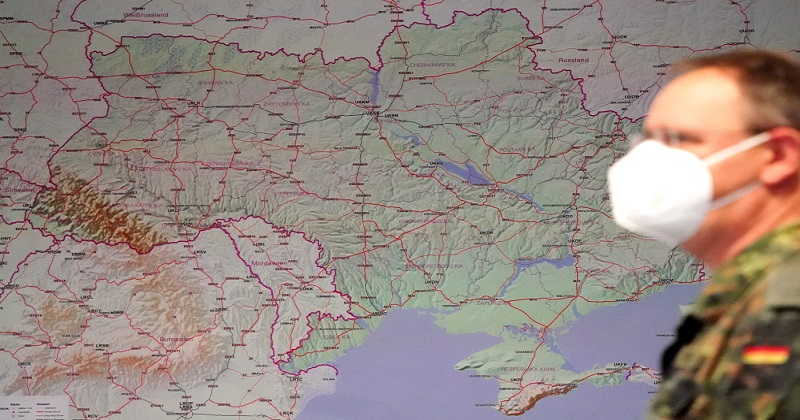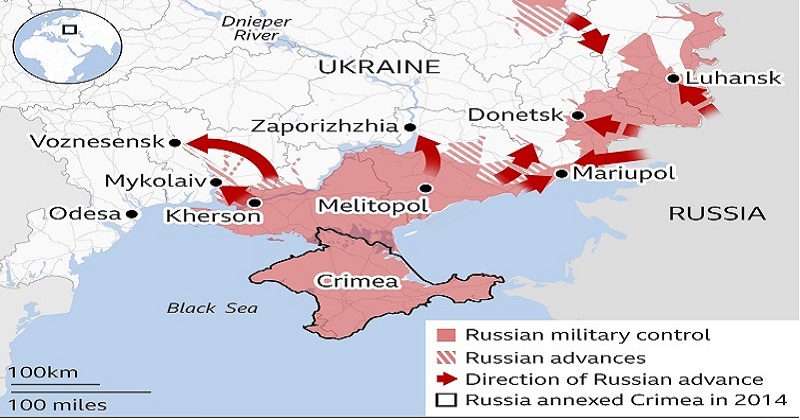
On 24 February, Russia launched its attack from all directions: north, south, and east. Land, sea, and airstrikes have been made against targets across the country.
Kyiv under siege:
In an attempt to encircle and cut off the Ukrainian capital, Russian troops are now moving towards the city from multiple positions. Satellite imagery shows that elements of a large Russian convoy to the northwest of the city are now being redeployed around the outskirts of the city. There has been some significant progress made by Russian troops heading towards Kyiv from Sumy in the east. Dr. Jack Watling of the Royal United Services Institute says Russian troops appear to be preparing for a siege of Kyiv rather than an aggressive invasion.
Russia’s slow progress in the north:
Though Russian troops are now making gains outside of Kyiv, their progress in the north has been much slower than in the south. The main advance towards the capital was from Belarus, where Russian troops were gathered, down the west bank of the Dnieper River via Chernobyl. The Russian column that reached Kyiv after reaching Hostomel airport, however, encountered strong resistance and experienced logistical problems, such as fuel shortage.
In the northeast, Russian forces have continued in their drive to take the city of Chernihiv. However, they have not yet advanced down the east bank of the Dnieper River. Troops coming from Sumy in the east have made progress and are nearing the capital, although reports indicate the supply lines are under great pressure.

Big Russian gains in the south:
From Crimea, Russian forces have advanced east and west across the south of the country. There is a growing concern for tens of thousands of civilians trapped in Mariupol, a port city surrounded by Russian forces. The UN says civilians in Mariupol, Kharkiv, Melitopol and elsewhere need aid, especially life-saving medical supplies. In Mariupol, bodies have been buried in mass graves of people who died of shortage of food , water , medical aid and also electricity. To the west, Russian forces around Kherson appear to be moving toward Mykolayiv and toward Odesa. The takeover of Odesa would seal off Ukraine from its coast and provide a path for Russian forces from Donetsk to Moldova.
Airstrikes in the east:
Friday morning, Russia targeted Dnipro, a key city along the Dneiper River, for the first time since it invaded. Three airstrikes occurred in the city, striking a shoe factory, an apartment block, and a nursery. One person died. A point of convergence for Russian forces coming from the south and east, Dnipro has a lot of heavy industry – including a rocket factory. Despite the intense aerial bombardment, Kyiv, the second-largest city in Ukraine, has not been recaptured by Russia. U.N. prosecutors are investigating possible war crimes in connection with artillery attacks on residential areas of the city. Experts report that Russian forces in the area have continued operations to the south east of the city, including efforts to take Izyum.
Thousands flee at borders:
According to the UN, more than 2.5 million people have fled Ukraine since the invasion began. It is the fastest-growing refugee crisis in Europe since World War Two. Children and young people make up around half of them, according to UNICEF.
The maps:
It has been using daily assessments published by the Institute for the Study of War in collaboration with the American Enterprise Institute’s Critical Threats Project to determine which parts of Ukraine are under the control of Russian troops. According to this daily assessment, starting on 2 March there will be ‘Russian-controlled Ukrainian territory’ and ‘Russian advances in Ukraine’, the latter indicating areas from which the Russians are believed to have launched attacks, but which they do not control.

Post Your Comments